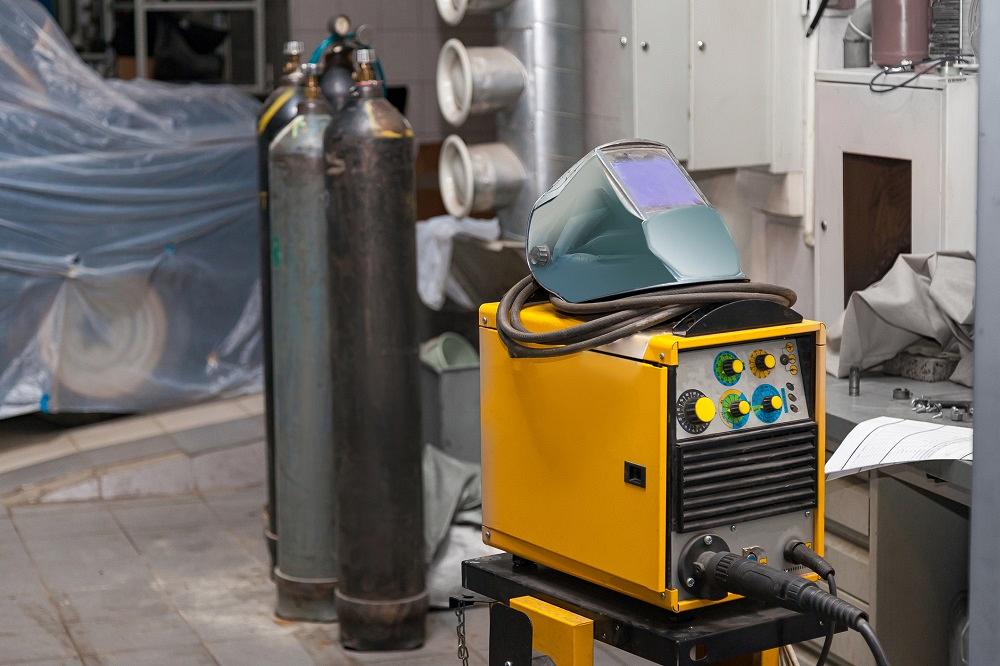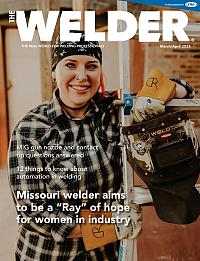Editor
- FMA
- The Fabricator
- FABTECH
- Canadian Metalworking
Categories
- Additive Manufacturing
- Aluminum Welding
- Arc Welding
- Assembly and Joining
- Automation and Robotics
- Bending and Forming
- Consumables
- Cutting and Weld Prep
- Electric Vehicles
- En Español
- Finishing
- Hydroforming
- Laser Cutting
- Laser Welding
- Machining
- Manufacturing Software
- Materials Handling
- Metals/Materials
- Oxyfuel Cutting
- Plasma Cutting
- Power Tools
- Punching and Other Holemaking
- Roll Forming
- Safety
- Sawing
- Shearing
- Shop Management
- Testing and Measuring
- Tube and Pipe Fabrication
- Tube and Pipe Production
- Waterjet Cutting
Industry Directory
Webcasts
Podcasts
FAB 40
Advertise
Subscribe
Account Login
Search
Electrical safety tips from three welding instructors
How welders can avoid electrical hazards while welding
- By Rafael Guerrero
- April 5, 2023
- Article
- Safety

To reduce or eliminate the risk of electrical hazards in shops and classrooms or on worksites, welding equipment should be properly maintained, inspected on a routine basis, and used as intended. Aleksandr Kondratov/iStock/Getty Images Plus
Have a question or need advice on avoiding electrical hazards while welding? Ask a welding instructor.
After all, most have real-world experience outside of the classroom that can resonate with future or current fabricators. They also have experience teaching electrical safety principles to new welders every day. In other words, welding instructors might be the best resources to help fill in the blanks about electrical safety.
Mark Poirier, welding instructor, and Mike Brandt, welding instructor/program chairman, at Lanier Technical College’s Dawsonville, Ga., campus; and Karsten Illg, welding instructor and department chair at College of Lake County in Grayslake, Ill., shared with The WELDER some tips and stories to help welders prevent electrical hazards in the shop, field, or classroom. While these tips do not encompass everything about electrical safety, these educators hope welders young and old will take this information to heart.
Water and Welding
Everyone knows that water and electricity do not mix, but all welders, at one point or another, find themselves in a position where moisture is unavoidable.
This presence of moisture may come in the form of rain, high humidity, or sweat. Be mindful of where moisture is while working.
“Make sure that you're insulated, that the equipment's adequate for the job, things like that,” said Poirier. “Check for damaged parts, that they are replaced or repaired. Make sure welding machines are properly grounded, that gloves are dry with no holes in them. And just be mindful of the presence of water or moisture all the time.”
Personal protective equipment (PPE) is important, they added. Wear boots and gloves and have a poncho ready—anything that can reduce or eliminate moisture exposure. Do not wear moist or wet PPE.
Poirier, whose experience outside of the classroom includes time as an iron worker and pipe welder, said to bring extra pairs of gloves in case a warm environment causes sweaty palms.
On rain, Poirier said: “The thing is, you don't weld in the rain. You don't weld in standing water. You just don't. But like I said, sometimes there's no other way so you’ve just got to do it properly.”
Mind Your Equipment
Welding equipment should be properly maintained, inspected on a routine basis, and used as intended. Equipment condition can often be overlooked, but it is one of the most important things to look for, said Brandt.

Welding instructors have real-world and classroom experience that can prove insightful when teaching welders about electrical hazards and how to prevent them. South_Agency/E+/Getty Images
“I’ll tell students, ‘When you're dealing with electrical plugs and that that sort of thing ... I don't recommend that you're mindful of it, it demands you being mindful of it,’” stressed Brandt, whose past work experience includes racing, welding, and fabricating.
Student welders are trained to inspect equipment for any issues, added Illg. This ranges from easy-to-spot issues like a broken torch/gun or electrode holder, to more difficult problems like a small cut in a wire/cable cover that exposes the core.
The objective is to prepare students for anything thrown at them, including the fact that they may not be the only ones using the equipment in a welding lab or shop.
“When you’re the sole user of the equipment, you become very familiar with it. But in a training environment or in a manufacturing environment where you have multiple users and don’t have a personal workstation, you never know what the last user did to it,” said Illg, whose career includes work in motorsports, machining, and fabrication.
Avoid shortcuts while repairing or maintaining equipment, they advised. If necessary, contact a professional electrician to make a repair, Brandt added.
“One thing that I will say about repairs, replacement, or getting new equipment up and running is making sure that qualified people are doing the work,” he said.
“There's some things that you just shouldn't ever take for granted.”
Student Curiosity
New welders may not ask many questions about electric safety right away, but their level of curiosity changes as they weld more. Eventually, they begin to ask more questions and begin to ponder the how—as in, how do welders stay safe while fusing metal together using an electric current?
“A lot of them don’t know what questions to ask until they’re immersed in it,” Illg said.
The three teachers make safety a big part of their instruction, especially as students get introduced to new processes. Safety training comes in the form of videos, online work, quizzes, and curriculum.
At times, Illg has shared a 2003 story about a farmer who died while welding. A National Ag Safety Database report of the incident said the 44-year-old man died from electrocution while welding a feed bunker wagon.
Illg said this story is effective in reminding students—and even himself—that electricity should not be taken for granted.
“The reaction, man, is it gets quiet because students again understand they can use this equipment, but [they] may not understand that if the equipment is damaged and not maintained to how the environment changes, you can create a dangerous situation,” he said.
Helpful Tips
The three instructors shared a few other tips on reducing or eliminating electric hazards while welding:
- Do not use welding gloves for material processing.
- Do not use welding leads that are too small, damaged, or poorly spliced.
- Do not wrap cables around your body.
- Do not touch the electrode with bare skin if you are in contact with the work or the ground.
- Do not touch the work with your bare skin during the welding process.
- Do not use welding leads submerged in water.
The American Welding Society’s Safety and Health Fact Sheet on electrical hazards recommends the following:
- Read the instructions, labels, and manuals before installing, operating, or servicing equipment.
- Train welders and others involved in welding operations on safe electrical work practices according to the employer, OSHA 1910.332, and ANSI Z49.1.
- Do not work alone in electrically hazardous conditions.
- Do not touch electrode holders connected to two welding machines at the same time since double open-circuit voltage can be present.
- Connect the work clamp to the workpiece/metal, as close to the point of welding as possible.
- Ground the workpiece to a good electrical earth ground when required by ANSI Z49.1 or other codes.
- Do not touch an energized electrode while you are in contact with the work circuit.
About the Author

Rafael Guerrero
2135 Point Blvd.
Elgin, IL 60123
(815)-227-8242
Rafael Guerrero. was named editor of The Welder in April 2022. He spent nine years as a journalist in newspapers in the Midwest and Pacific Northwest, covering topics and communities in central Illinois, Washington, and the Chicago area.
About the Publication
subscribe now

The Welder, formerly known as Practical Welding Today, is a showcase of the real people who make the products we use and work with every day. This magazine has served the welding community in North America well for more than 20 years.
start your free subscription- Stay connected from anywhere

Easily access valuable industry resources now with full access to the digital edition of The Fabricator.

Easily access valuable industry resources now with full access to the digital edition of The Welder.

Easily access valuable industry resources now with full access to the digital edition of The Tube and Pipe Journal.
- Podcasting
- Podcast:
- The Fabricator Podcast
- Published:
- 04/16/2024
- Running Time:
- 63:29
In this episode of The Fabricator Podcast, Caleb Chamberlain, co-founder and CEO of OSH Cut, discusses his company’s...
- Trending Articles
Sheffield Forgemasters makes global leap in welding technology

ESAB unveils Texas facility renovation

Engine-driven welding machines include integrated air compressors

How welders can stay safe during grinding

The impact of sine and square waves in aluminum AC welding, Part I

- Industry Events
16th Annual Safety Conference
- April 30 - May 1, 2024
- Elgin,
Pipe and Tube Conference
- May 21 - 22, 2024
- Omaha, NE
World-Class Roll Forming Workshop
- June 5 - 6, 2024
- Louisville, KY
Advanced Laser Application Workshop
- June 25 - 27, 2024
- Novi, MI


























